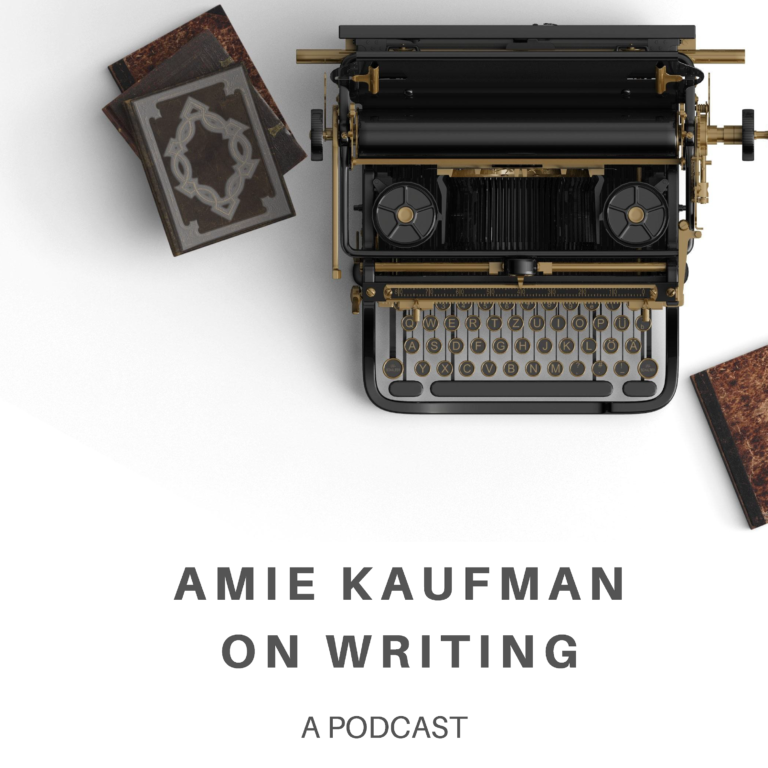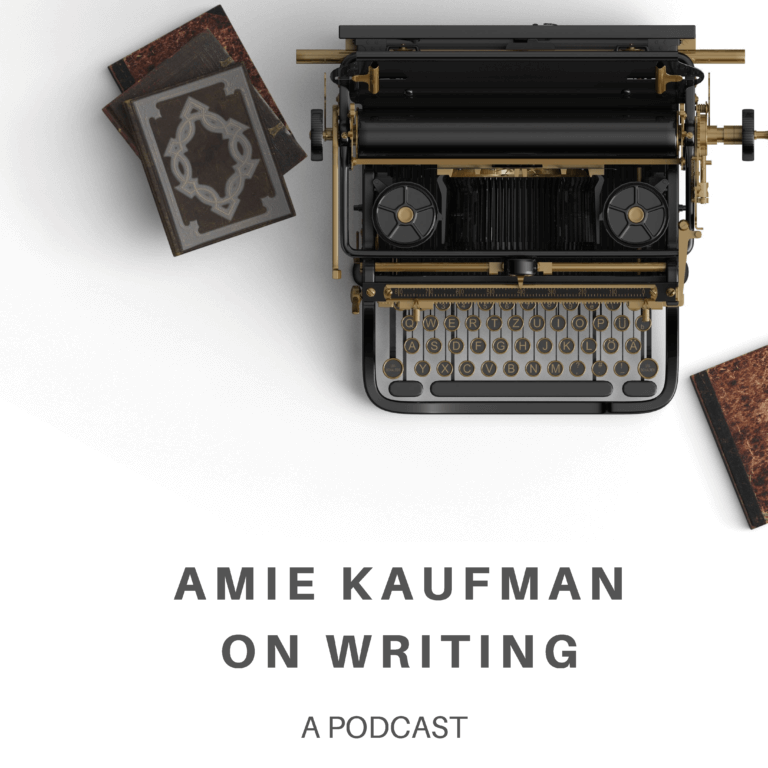Episode 9: Four Ways to Visualize Your Setting

New York Times and internationally bestselling author Amie Kaufman answers one question each week about writing craft. Full of practical tips and an exercise each week, this is a show for writers, for readers who want a backstage look at how their favourite authors craft their stories, or for creative writing classrooms.
Your setting is essentially a character in your story, and has so much to tell us. The location in which your story is set should matter—it should be relevant that the story takes place here, rather than somewhere else, and it should influence the way the story unfolds. Setting is so important that I’ve dedicated the final two episodes of season one to it—this week we’re talking about visualizing your setting, and next week we’ll talk about weaving it into your writing. Let’s get into it.
You can find a transcript of this episode at my website, where you can also subscribe to my newsletter, get behind-the-scenes peeks at how I write, and any other news about new books, events or the podcast. You can also submit a question for the podcast on my website. You can find me on Twitter or Instagram.

FOLLOW ON APPLE PODCASTS . FOLLOW ON SPOTIFY . FOLLOW ON OVERCAST . FOLLOW ON PODCAST ADDICT
Season 1, Episode 9: Four Ways to Visualize Your Setting Transcript
Hi, my friends.
Welcome to Amie Kaufman on Writing, a short podcast that answers one question each week about how writers do what they do.
If you’re a writer, or you’re a reader interested in how your favourite authors craft their stories, then you’re in the right place.
This is Season 1, Episode 9: Four ways to visualize your setting.
As always, here’s my friend and producer Kate with this week’s question. Hi Kate, how are you?
Hi Amie, I’m good!
This week’s question is from Nat, who says: Hi! I wanted to ask: What’s your process for visualizing your setting, both when planning your novel and during the writing process? Do you recommend Pinterest boards or maps, or something else?
So, Nat has hit on something really important. Your setting is essentially a character in your story, and has so much to tell us. The location in which your story is set should matter—it should be relevant that the story takes place here, rather than somewhere else, and it should influence the way the story unfolds.
Imagine you’re sitting in an interview room. There’s a plain table, two chairs. You occupy one, the other is empty. Fluorescent lights overhead, and one of them has a faint flicker and buzz that’s really, really starting to annoy you. But you don’t want to react, because you don’t know if anyone’s watching you from behind the mirror in the wall. Someone before you has picked away at the edge of the table—with their thumbnail, probably. Maybe they were bored, or nervous.
Now picture somewhere else—a path that leads to the beach. It funnels you down between a couple of sand dunes, and as you make your way along it the sand gives way a little beneath each footstep, so you’re part walking, part running, part skiing toward the surf below. Everything smells of saltwater and sunscreen, and you can still taste the watermelon you were eating while you waited for the others to find their towels. Yours is flapping against your back as you slither down toward the water, and it’s going to be a good day.
Pretty different to the interview room, right? Do you see how with very minimal action, very minimal thought, the setting creates two completely different feelings? Now, I probably wouldn’t include a long piece of setting like that very often in my writing, but I wanted to demonstrate how important it is to avoid what writers and editors call White Room Syndrome.
What’s that? It’s when you include so few details of your setting that the action could be taking place in a plain white room, for all we know—nothing grounds the reader in a particular time or place.
Setting is so important that I’ve dedicated the final two episodes of season one to it—this week we’re talking about visualizing your setting, and next week we’ll talk about weaving it into your writing. So let’s get into it. Here are four ways to visualize your setting – because you have to know what it’s like, before you can convey that to your reader.
Option one: Good old visual research. This one’s basic, but incredibly helpful. Look for documentaries, look for TV shows or movies set in the sort of place you’re writing about, and study the background rather than the plot. Look at the trees, the architecture, the weather. Jump on Pinterest and gather a collection of images of the sorts of locations to be found in your story—taking a moment to look at them (without falling down a hole and following graphics about how to make a unicorn cake or fold a fitted sheet)—taking that moment to look at them can really ground you in your setting before each writing session, helping you reenter the world of your story and include details of your setting.
Method number two? Maps. Now, full disclosure, I’m a giant map nerd, but maps can be helpful for everyone. One option is to make your own—and you don’t have to spend endless hours sketching it to perfection, it’s just often helpful to know that there are mountains just outside the city, or which part of your village is along the river, or what’s next door to the school. That can shape the sorts of things the characters see, hear, smell, and experience.
Another option is to look at real maps—if your location is real then that’s easy, and I’d suggest looking around to see what different kinds of maps you can find. Rainfall? Population density? If your location is an imagined place, either in our world or another one, then find maps of similar places. What do you notice about them? Is there a main street? Are they usually on the water? Are they long and thin, to fit in a valley? How many schools do they have?
All these sorts of questions can help you picture specific details about your setting—and specificity is the name of the game, here.
So that’s visual research, and maps. Method number three for visualizing your setting is to go back to your worldbuilding steps. Remember wayyy back in episode two, we talked about figuring out the thing that’s different about your setting? If your story is set somewhere with terrible air quality, your setting might be designed to help people stay indoors—maybe there are tunnels connecting buildings, or more indoor malls than outdoor shops. If your setting is pre-industrial, what do those differences in technology mean for what your character smells, the textures they notice around them?
The fourth and final suggestion I have for visualizing your setting is to do a little interview work. If you have the chance to speak to somebody who’s been somewhere like the place your story is set, ask them about it. If that’s you, take a moment to slow down and ask yourself!
What’s their favorite sensory detail about the place they live? What often surprises newcomers? When they’ve been away from this place, what tells them they’re home?
When Jay and I were writing the Illuminae Files, we set some of the action on a planet that’s entirely snow and ice. Now as a pair of Aussies, this isn’t our strong suit. I’d seen a little snow on my travels around the world, Jay had never seen any at all.
I remember talking to an Alaskan about some of the things that made her home unique. She told me at the coldest times of year, when the locals head into a restaurant they leave the motor running on their cars, because otherwise they won’t start again later. She said you come out after your meal to a parking lot full of headlights, instead of darkness. She said that when you park your car in the street, you leave the doors unlocked in case someone’s being chased by a bear and needs a bolt hole. She said that if you’re not taking your shoes off before you go inside, you knock your boots against the doorframe to shake off the worst of the snow.
Now, I don’t know if she was just having fun with me with those first two, but quite frankly, I didn’t want to know—they were great stories! And since I wasn’t writing something set where she lived, but rather on another planet, they really helped me imagine the ways in which a snowy setting can affect everyday life. And from there I could extrapolate my own.
So there you have it: four ways to visualize your setting: find documentaries, TV shows or still images that show it, use maps, consider what setting details might spring from the unique things about your world, and speak to people with experience of your kind of setting.
Here’s an exercise: If you’re a writer, think about one aspect of your setting—it could be large, like whether the setting is urban or rural, or small, like a particular room a scene takes place in. Spend a couple of minutes jotting down specific details that come with that piece of your setting—how could they influence the action, or the feeling of the story?
If you’re a reader, take a look at the first chapter of a book you like. What are three details of setting that the author includes that help plant you in a time or place, or establish a certain mood?
That’s it for this week! Next week, I’ll be answering the season’s final question, which is about how to weave your setting through your writing, once you know a little more about it.
After that we’ll be taking a break, but we’ll be back with season two around the end of the year. And I’m planning on dropping a few very cool surprises into the feed in the meantime, so make sure you’re subscribed—you won’t want to miss them. If you’ve enjoyed the season so far, I’d really appreciate it if you’d leaving a rating and a review where you listen, or tell a friend about the podcast, or both!
You can find me at my website, which is at amiekaufman.com – you can subscribe to my newsletter there, for behind-the-scenes peeks at how I write, and any other news about new books, events or the podcast. You can also submit a question for the podcast on my website. You can find me on instagram at @AmieKaufmanAuthor or on twitter at @AmieKaufman. This podcast is produced by the lovely Kate Armstrong, host of one of my favourite podcasts, The Exploress, which time travels through women’s history one era at a time. You can find her at theexploresspodcast.com.
For now, thanks so much for listening – enjoy your reading, and enjoy your writing.
Have a Question?
You can submit your question using the form using the form on the main podcast page — if you’re stuck on one aspect of your work, or you’re wondering how your favourite author pulled something off, we’d love to hear from you!
